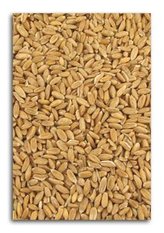
Spelt is an ancient grain with a modern appeal. Spelt is a member of the wheat family but is an entirely different species. It's one of the original 7 grains mentioned in the Bible. The 9000 year old grain originated in Iran and over the centuries found its way to Europe where is has remained a very popular grain for hundreds of years. The Germans call it "Dinkel" and is now found in a wide variety of foods and beverages from bread to beer; the Italians call it "Farro" and use is in pizza crust, breads and cakes.
Spelt has a mild flavor and can be used in breads and many baked goods My personal experience is,if you want a lighter yeast product use Spelt as half the flour in the recipe. Spelt has a tough outer hull protecting the kernel which makes it difficult to dehull and clean the grain. It's believed that the impervious outer hull allows for the development of a more delicate, water soluble kernel. The protein or gluten found in Spelt is much more fragile than that found in wheat which makes it necessary to reduce the mix times when baking bread. Some people claim they can eat Spelt even though they're sensitive to wheat. That may be true,especially in a fermented bread like sourdough. Spelt actually has more protein than wheat, and the protein contains gluten, so it's not suitable for a gluten-free diet. If you're sensitive to wheat or other grains, you should speak to your health care provider before eating Spelt.
Health Benefits of Spelt
The combination of nutrients in Spelt seems to enhance the immune system and to aid in the clotting of blood. Spelt also appears to be helpful for those who suffer from migraine headaches, atherosclerosis and diabetes. The fiber and niacin in Spelt can improve cardiovascular health and decrease the risk of heart disease, and the combination of magnesium and fiber in Spelt flour may lower the likelihood of developing type 2 diabetes.
Spelt has a mild flavor and can be used in breads and many baked goods My personal experience is,if you want a lighter yeast product use Spelt as half the flour in the recipe. Spelt has a tough outer hull protecting the kernel which makes it difficult to dehull and clean the grain. It's believed that the impervious outer hull allows for the development of a more delicate, water soluble kernel. The protein or gluten found in Spelt is much more fragile than that found in wheat which makes it necessary to reduce the mix times when baking bread. Some people claim they can eat Spelt even though they're sensitive to wheat. That may be true,especially in a fermented bread like sourdough. Spelt actually has more protein than wheat, and the protein contains gluten, so it's not suitable for a gluten-free diet. If you're sensitive to wheat or other grains, you should speak to your health care provider before eating Spelt.
Health Benefits of Spelt
The combination of nutrients in Spelt seems to enhance the immune system and to aid in the clotting of blood. Spelt also appears to be helpful for those who suffer from migraine headaches, atherosclerosis and diabetes. The fiber and niacin in Spelt can improve cardiovascular health and decrease the risk of heart disease, and the combination of magnesium and fiber in Spelt flour may lower the likelihood of developing type 2 diabetes.
 RSS Feed
RSS Feed
